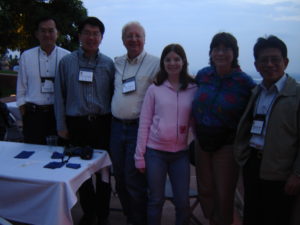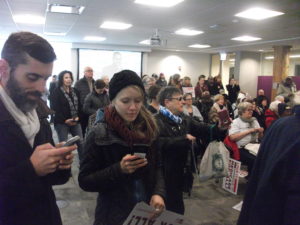For many Americans, including numerous prominent Republicans, one of the more troubling phenomena in the 2016 presidential election was the rise of certain groups who seem to attach their own identity to resentment and rejection of those who do not fit traditional images in our culture. The frequently demonstrated reluctance of Donald Trump to distance himself from advocates of white nationalism or supremacy served only to reinforce a sense of unease about the direction our nation was taking. The situation raised some disturbing questions about who we are as a nation at the same time that it also revealed a very real sense of the loss of possibility among those who embraced the Trump messages. Before we hasten to condemn this trend, it is important to keep in mind that many of the people who launched Trump into the White House have felt a very real unease of their own, a feeling of losing their footing in what they experience as a stagnating economy. The feeling transcended party boundaries and went a long way toward explaining the surprising popularity of the Bernie Sanders candidacy in the Democratic primaries. This great stirring is far from over just because Trump won.
I do not raise this issue to reach any partisan conclusions or even to address it in any specifically political terms. But I was moved to think about it in part after observing some of the more blatant instances of racist prejudice in post-election interviews with the likes of Richard Spencer and his National Policy Institute. Spencer grabbed some attention with a speech that included the phrase “Hail Trump,” a barely veiled echo of “Heil Hitler,” and, according to a recent article in The Atlantic, made clear his dream is “a new society, an ethno-state that would be a gathering point for all Europeans,” and has called for “peaceful ethnic cleansing.” It is hard to imagine how ethnic cleansing can possibly be peaceful, so I think one can hardly be blamed for suspecting deceitful propaganda. No matter how many disclaimers the alt-right may use in trying to reframe its identity, the old stench of the Ku Klux Klan and neo-Nazi movements refuses to go away.
But I want to make a larger point and then delve into the very question of how we frame identity, and how it frames us. Our sense of identity can be both liberating and oppressive, both loving and resentful, thoughtful and downright stupid. Spencer, in a recent television interview, effectively expressed the notion of simply claiming his white identity in the same way that blacks take pride in theirs. Many on the alt-right take pains to note how much white people have contributed to our society as a means of expressing dominance. This is rather simplistic for the obvious reason that our society long was of predominantly European origin, so it stands to reason that most of our heritage bears that mark. But it is not nearly so simple as all that. The whole notion bears some dissection.
What has come to be identified as the African-American experience, for starters, resulted from a forced common experience of bondage in which most slaves lost any or most of their specific African heritages under circumstances that were not only unquestionably racist but involved violent subjugation as well. It is no accident that black slaves often readily identified with the biblical story of the Israelite release from slavery. Liberation movements throughout world history have played a role in forging new identities through struggle. The fact that the struggle has continued to this day in the form of civil rights battles has served only to strengthen those ties.
And yet—one needs only to observe the assimilation into American society of African and Caribbean black immigrants to realize that there are subtleties and variations in the African identity. President Barack Obama himself, the son of a white woman from Kansas and a Kenyan student at the University of Hawaii, struggled in his youth to establish his own sense of identity, which did not come from claiming slave ancestors in the Deep South. In current American society, one can see expressions of Ghanaian culture, as well as of Ethiopians, Nigerians, and Somalis, all arriving long after the most bitter civil rights and liberation struggles have been fought, seeking to establish their own ethnic identities in a very diverse America. The tapestry is ornate and continues to enrich American society with everything from new cuisines and artistic expression to new ways of understanding what attracts people to the American dream.
These variations and nuances extend to the frame of “white American” experience. Because what became the United States of America began with English colonies, the experience of early Americans was very English in nature—but not entirely. Early on, the British empire absorbed Dutch and French settlers into its universe, as well as a modest number of American Indians who intermarried. (It should also be noted that perhaps one-fourth of African-Americans have some American Indian ancestry, in no small part because of slaves escaping to Indian communities and integrating and intermarrying over time. See Black Indians for just one interesting exposition of this fascinating history.) Over two or three centuries, “white” America gradually absorbed more non-English elements, beginning with the Irish and Germans, and eventually including all sorts of largely non-Protestant immigrants from southern and eastern Europe as well as Lebanese, Turks, and others.
All these people brought with them unique cultural attachments. For example, Greeks brought not only their Orthodox church, but numerous specific perspectives on the world based on their own historic and philosophical outlooks, all tempered over time by new experiences in the New World. In many cases, those initial experiences included some discrimination and challenges in becoming American. Any serious student of American history is aware of such phenomena as the Know-Nothing movement of the 1840s and 1850s, a period when factory doors often sported signs indicating that “Irish need not apply.” Tensions boiled over at times, including one notable instance in Chicago in 1855 known as the Great Lager Beer Riot. Know-Nothing Mayor Levi Boone sought closure on Sundays of the pubs and bierstuben that the Irish and German workingmen patronized, and a confrontation erupted. Boone became a one-term mayor, and his initiative came to naught.
The targets of white-on-white discrimination shifted over time into the early and even mid-20th century, as assimilation proceeded and various nationalities won grudging acceptance. American literature is replete with very personal interpretations of these experiences from Norwegians, Lebanese, Greeks, Russians, and others trying to find their place in American society. One astute student of the subtleties of this evolution, Mel Brooks, generated the biting and wickedly comic satires Blazing Saddles. I have long felt that movie, which I have watched several times, offers far more insight than meets the unlearned eye into the sometimes explosive mixture of influences that shaped the American West. My own discerning eye for the subtleties of this movie came after living in Iowa for more than six years and researching a book on the farm credit crisis, as well as marrying a Nebraskan, all of which made me very aware of the diverse ethnic communities that comprise much of the West. Rural America is not nearly as monochrome as many urban Americans imagine it to be.
Let me return briefly to the phony vision of the alt-right. What I have just described should make abundantly clear that the notion of “white identity” can have only one purpose. That purpose is white supremacy and the oppression of minorities because the overall “white” experience in America is itself so diverse and has evolved so far from its English colonial roots that the only possible meaning one can attach to this “white identity” is that of suppression of any other form of identification with the meaning of “American.” I also do not think a blog article like this can do more than scratch the surface of this subject. Whole books have been devoted to the formation of personal and collective identity in the American melting pot without successfully exploring all the nooks and crannies of the issues involved. Nonetheless, I strongly believe we must keep this subject open for further exploration. We have little choice if we want to understand both ourselves and what is happening around us.
I also want to make clear that I do not believe that Donald Trump is endorsing white supremacy. What troubles me is his willingness to exploit this sentiment to advance his political ambitions. Many of the obvious splits within the Republican party had as much to do with the discomfort of Mitt Romney, John Kasich, John McCain, and the Bush family, among others, with this exploitation of prejudice as with any other stance that Trump took. These past Republican leaders simply found themselves unable to stomach such intolerance. Trade and foreign policy issues are fair game in a presidential contest, but for reasons related to his own view of the imperative of winning at any cost, there is little question that Trump took the low road in making his arguments. That choice will leave him mending fences for the next four years if he truly wants to be president of “all the people.”
Ultimately, our collective national identity is a composite of the many individual identities we construct for ourselves. Some of us construct these identities carefully and deliberately over many years, and others simply accept inherited attitudes, privileges, or resentments. But one of the central claims of the conservative right has been that America has traditionally been a Christian nation. That is a position that, in some respects, also ignores the freedom of religion that is enshrined in the First Amendment, which includes the right of people to observe other faiths or no faith at all. But I would prefer to confront white identity on Christian grounds both because I am willing to claim Christian identity and because real Christian faith flatly excludes white identity: “For in Christ there is no longer Greek nor Jew, slave nor free, male or female.” (Galatians 3:28) Saint Paul did not need to add “black nor white” to make his point perfectly clear. The only thing that is remarkable is how often this simple point is missed or ignored.
Another piece of Christian wisdom is well known and comes directly from Jesus (Luke 12:48), that from those to whom much has been given, much also is demanded. I can think of few things more appalling than to waste one’s life and talents disseminating hatred and bigotry in a world badly in need of greater love and understanding. An honest search for our collective or personal identity demands both an open mind and respect for our fellow citizens. I can think of nothing that would ever alter my perspective on that final observation.
Jim Schwab






